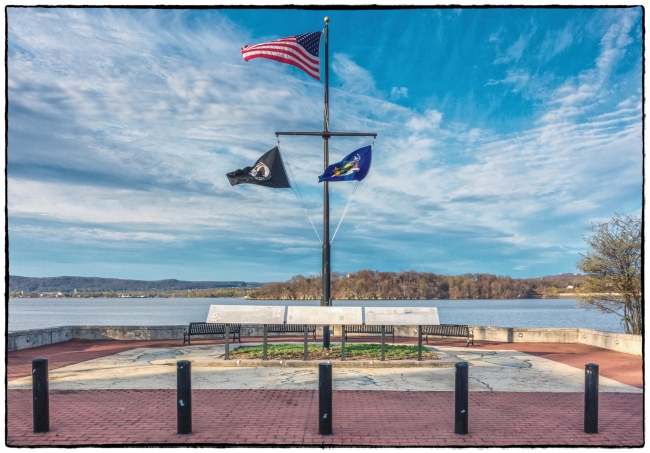It doesn’t look much nowadays, but this somewhat out of the way location was very significant during the Revolutionary War.
According to the ‘A Revolution Day‘ website, which provides one day itineraries for visiting Revolutionary War sites by car (this from the section on Route 9):
Kings Ferry was a major crossing point on the Hudson. It connected Verplanck’s Point on the east side of the Hudson with Stony Point on the west side. Since the British controlled New York City for most of the war, Kings Ferry was the southernmost crossing point for American personnel and supplies for most of the war. It was also a very important communication line between the north and the south. Therefore, Kings Ferry was a very strategic target for the British.
On October 5, 1777, Clinton dispersed the American forces at Verplanck’s Point and landed 3,000 troops to secure the area for an attack up river. On October 6th, they took Stony Point across the river and then moved north to take Fort Montgomery, Fort Clinton and Constitution Island.
On October 8, 1777, George Washington sent a letter to William Livingston. “Sir: I yesterday received certain intelligence, that the enemy had proceeded up Hudson’s River from New York, and landed a body of men at Verplanck’s Point, a few miles below Peekskill. … Should any disaster happen, it is easy to foresee the most unhappy consequences. The loss of the Highland passes would be likely to involve the reduction of the forts. This would open the navigation of the river, and enable the enemy, with facility, to throw their force into Albany, get into the rear of General Gates, and either oblige him to retreat, or put him between two fires.”
On May 30, 1779, the British returned to Kings Ferry. Six thousand troops left New York City, by land and water, and moved north toward Stony Point. On June 1st, while 40 American soldiers were finishing a blockhouse at Stony Point, the first British ships appeared in Haverstraw Bay. The soldiers burned the blockhouse and fled.
Also on June 1st, British forces attacked 70 North Carolina troops stationed at Fort Lafayette at Verplanck’s Point. The American troops surrendered cutting off the important east-west link at King’s Ferry. Also, the victories put the British in control of the gateway to the Hudson, just 12 miles south of West Point.
On the night of July 15-16, 1779, Brigadier General Anthony Wayne of Pennsylvania led the American Light Infantry in a daring midnight assault against the British forces at Stony Point. Two American columns outflanked the front line defenses and captured the garrison. The main assault column waded through the shallow waters of Haverstraw Bay, south of Stony Point. The secondary column approached around the north side of the Peninsula. The American victory at Stony Point was the last major battle in the north.
After the battle, the Americans destroyed the fort, removed the prisoners, and captured supplies and equipment, including 16 pieces of artillery. Two days later, General Washington abandoned the peninsula, having determined that it could not be defended against the combined might of the British army and navy.
When the Americans withdrew, the British returned, and built a second fort with blockhouses surrounded by an abatis, but the war continued to expand. Crown forces were fighting the French and the Spanish, now allied with the Americans. The additional burden on military resources, a decision to move the war to the American south and a lack of reinforcements compelled the British to abandon the forts at Stony Point and Verplanck’s Point in October 1779. Kings Ferry was once again the southernmost crossing point on the Hudson.
In August 1781, Washington made the pivotal decision of the American Revolution. He decided to abandon operations in New York, sneak across the Hudson at Kings Ferry with French troops under the command of General Rochambeau and immediately march to the south to surprise Cornwallis at Yorktown. The American victory at Yorktown was the last major battle of the American Revolution.In the summer of 1782, the Continental Army took to the field for the last time at Verplanck’s Point. In a show of strength, the combined armies of General Washington and General Rochambeau demonstrated their might to the British bottled-up in New York City. The combined forces totaled 12,000.
The defeat at Yorktown, the assistance of the French and a war that had become unpopular in England forced the British to the peace table. Congress ratified the peace treaty on April 15, 1783 and the British evacuated New York City on November 25, 1783.
Today, a marker and a small park are at the spot where Kings Ferry leaves Verplanck’s Point. Across the Hudson, is the Stony Point Battlefield. On a clear day, you can see the lighthouse at Stony Point.
The small white dot on the opposite side of the river, and to the right of the flagpole, is the lighthouse at Stony Point. Just behind it is the site of the Battle of Stony Point mentioned above.

